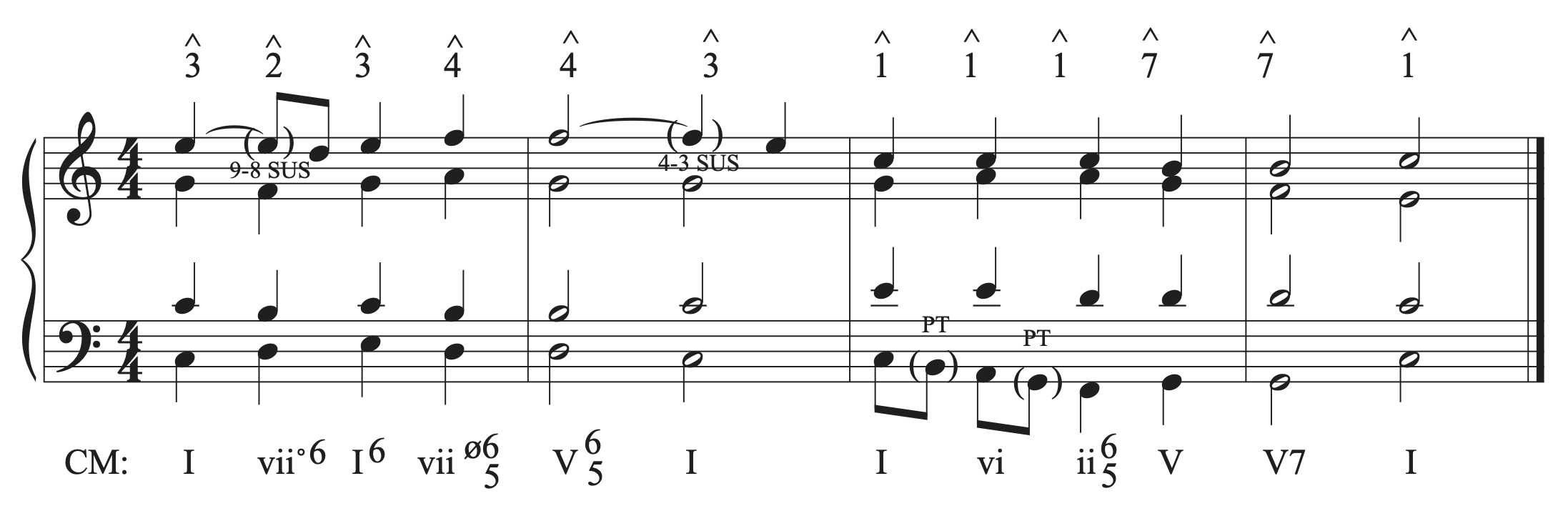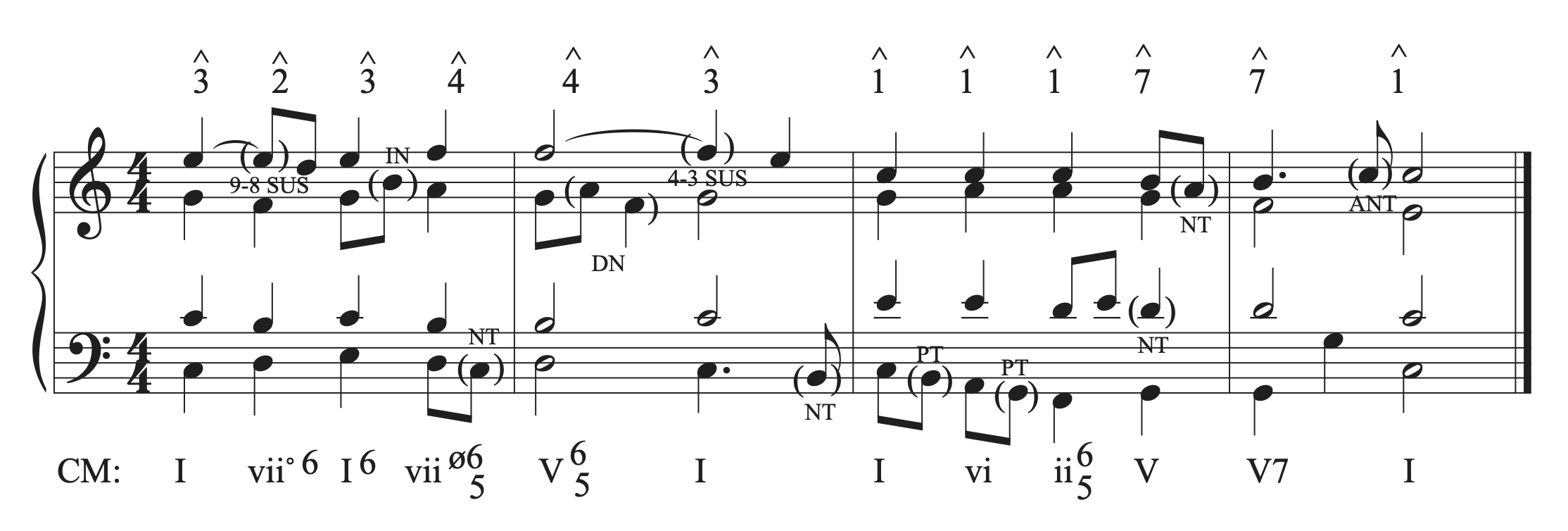11.5 Harmonizing a Melody With Non Chord Tones: Theory exercises
In addition to Workbook Chapter 11.5, see the example below.
Let’s take a look at an example to add NCTs. We will use the harmonizing a melody solution found for harmonizing seventh chords in chapter 11.4. Here is the completed melody harmonization and recording.

When looking for places to insert NCTs, first, we want to find places for the NCTS that have the most specific limitations on where they can be placed and how they can move. Suspensions are a good example, so we will start by looking for places where a suspension can be added. Suspensions need to move down by step to resolve, so we are looking for descending stepwise motion in a single voice between two chords. The intervals created by the suspension and resolution over the bass of the second chord will also have to be one of the types of suspensions used in music: 9-8, 7-6, 4-3, 2-3. The first place we see that motion is between the first 2 chords in bar 1. We could put a 9-8 SUS in the soprano, a 4-3 SUS in the alto, and a 7-6 SUS in the tenor. Since we are just starting the piece, and suspensions are often more effective in the melody, let’s add a 9-8 SUS to beat 2 of bar 1.

Let’s see if we can find another type of suspension to add to bar 2. The bass and soprano could support a suspension on beat 3. Let’s add a 4-3 SUS to the soprano line. Notice that the suspended note is the chordal 7th. By adding the suspension, we are delaying the resolution, not decorating between the chordal 7th and its resolution.

Next, let’s look at places to insert other NCTS. Passing tones are one of the most frequently used NCTs. Normally, adding passing tones to a piece of music is easy and there are many places to put them. However, since our goal when part writing is to create smooth, stepwise melodic lines, there are less places where we can add diatonic passing tones between notes a 3rd apart. If we look at the score, the first place that has a third in a single voice, is the soprano in bar 2 on beat 3. However, we already inserted a suspension in that spot, so can’t use an additional passing tone there. The bass line in bar 3 has two places where we can insert passing tones. They will create motion in the progression and provide interest in the bass line.

The rest of bar 3 now needs some NCTs added to beats 3 and 4 in order to keep the motion going that was created in beats 1 and 2. On beat 3, we can add a neighbor tone in the tenor. On beat 4, we can add a neighbor tone in the alto. Neighbor tones are usually the easiest to add to a melody harmonization because of the preferred use of common tones between chords. It’s a good idea to spread NCTs across all voices to add interest to the music and variety for the ear when listening.

The added NCTs in bar 3 have created a drive to the final cadence, but the longer note values in the last bar stop the motion and the lines sound too bare. An anticipation is a great choice of NCT to add before the final note of the piece in the melody. We can also have the bass change octaves to create rhythmic variety in the last bar. This is not a non-chord tone, but adding chord tones can also be used to decorate a melody. Chord tones do not need to be labeled in the score. Adding the extra chord tone rhythm and the anticipation continue the motion towards the final cadence.

Now that bars 3-4 have been ornamented, let’s revisit bars 1-2 to add more motion so that the opening bars have the same feel as the last 2 bars. In bar 1, we can’t add anything else between beats 2 and 3 due to the suspension, but we could place a NCT between beats 3 and 4. Let’s use a NCT we haven’t used yet, an incomplete neighbor, and add it to the alto line for variety. Then we can add a NCT between beats 4 and 1 in that bar. Let’s decorate the bass voice to contrasts with the soprano. We can use a lower neighbor tone. Notice that we do not want to decorate the A in the alto, since it is the chordal seventh.

Only two more spaces between chords are left without NCTS. We can decorate the long note on beat 1-2 of bar 2 by adding a NCT. Let’s insert a double neighbor into the alto voice, since we haven’t used that type of NCT before and have enough space to accommodate a double neighbor. When using a double neighbor, you have to choose a rhythm for the figure. We can use two eighth notes followed by a quarter note in order to mimic the rhythm used in the bar before on beat 3. This provides some cohesion and repetition, which will be recognizable to the listener.
We can also add a NCT to end of beat 4 in bar 2 to connect it to the next phrase. This is a common way of connecting a weaker cadence to the music that follows. Because we have the suspension resolving on beat 4, the NCT, which we can add as a NT in the bass, needs to happen after the downbeat on beat 4.

Now that we’ve added NCT between all beats, let’s listen to compare the original progression to the final progression.

